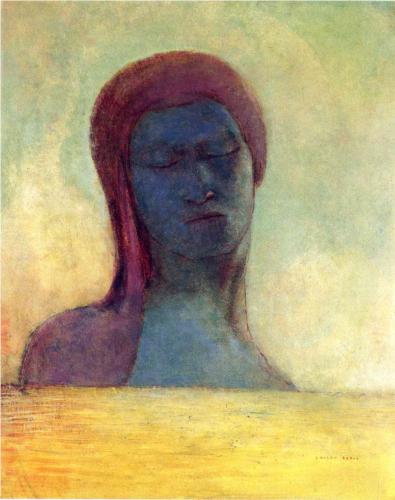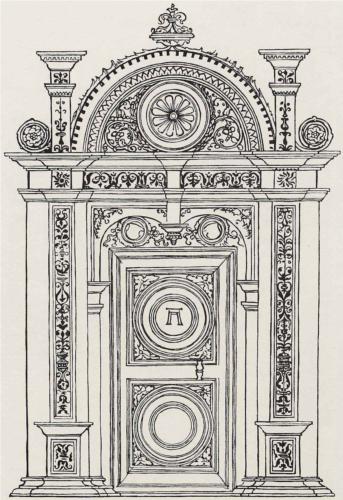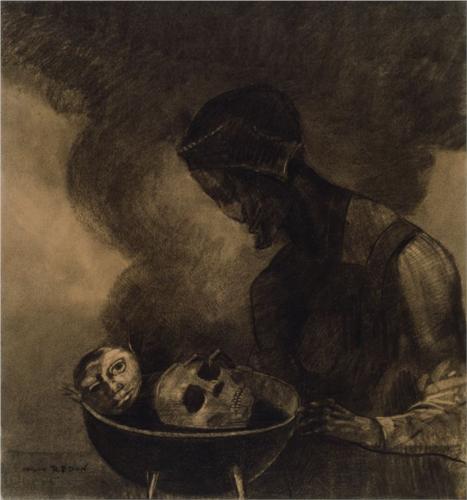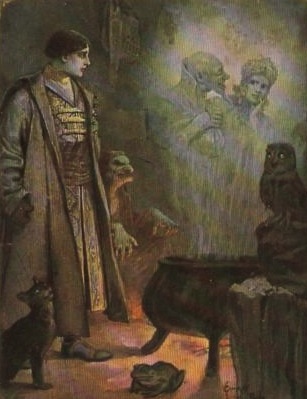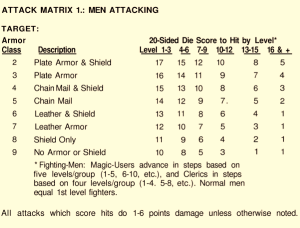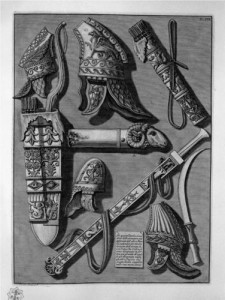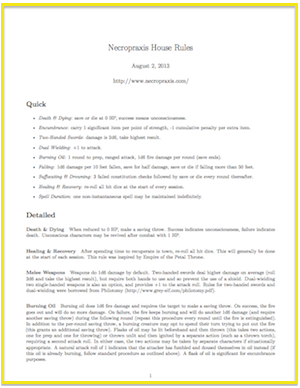
Necropraxis House Rules PDF (click to download)
I have finally compiled my most frequently used house rules into a PDF. Click on the thumbnail image to download the PDF.
Some notable changes (probably only of interest to my immediate players):
- Save to retain spells for magic-users is no longer active, mostly because we always forget to do it in practice. I still like the idea, though LS has informed me that adopting this rule in his own game has seemed to have made a particular magic-user PC dominant.
- Scrolls now require only 1 week to craft, irrespective of the spell level (GP costs are unchanged). What this means in practice: players can make one scroll as a downtime action.
- I managed to restrain myself and only sneak in one new house rule in the process of writing this document, which is sustaining spells (to replace traditional durations). This is from my recent work on magic for JRPG Basic.
Not currently present, but likely in some future update:
- Poison rules. I still haven’t figured out a method that I am happy with, mostly because I would like something that makes thieves better at using poison than other classes.
- Attack progressions. I’m currently using this attack ranks system, but I’ve come to feel that it is a bit cumbersome and the starting probabilities are maybe too generous. Possibilities that I have been considering: use the MEN ATTACKING table exactly as presented on page 19 of Men & Magic, but give fighters an additional flat +1 to hit, or switch to using hit dice as attack bonus (I floated this idea once, but the reaction from players was not enthusiastic).
Following are the house rules in HTML for easy reference, in both quick and detailed forms.
Quick
- Death & Dying: save or die at 0 HP, success means unconsciousness.
- Encumbrance: carry 1 significant item per point of strength, -1 cumulative penalty per extra item.
- Two-Handed Swords: damage is 2d6, take highest result.
- Dual Wielding: +1 to attack.
- Burning Oil: 1 round to prep, ranged attack, 1d6 fire damage per round (save ends).
- Falling: 1d6 damage per 10 feet fallen, save for half damage, save or die if falling more than 50 feet.
- Suffocating & Drowning: 3 failed constitution checks followed by save or die every round thereafter.
- Healing & Recovery: re-roll all hit dice at the start of every session.
- Spell Duration: one non-instantaneous spell may be maintained indefinitely.
Detailed
Death & Dying
When reduced to 0 HP, make a saving throw. Success indicates unconsciousness, failure indicates death. Unconscious characters may be revived after combat with 1 HP.
Healing & Recovery
After spending time to recuperate in town, re-roll all hit dice. This will generally be done at the start of each session. This rule was inspired by Empire of the Petal Throne.
Melee Weapons
Weapons do 1d6 damage by default. Two-handed swords deal higher damage on average (roll 2d6 and take the highest result), but require both hands to use and so prevent the use of a shield. Dual-wielding two single-handed weapons is also an option, and provides +1 to the attack roll. Rules for two-handed swords and dual-wielding were borrowed from Philotomy (http://www.grey-elf.com/philotomy.pdf).
Burning Oil
Burning oil does 1d6 fire damage and requires the target to make a saving throw. On success, the fire goes out and will do no more damage. On failure, the fire keeps burning and will do another 1d6 damage (and require another saving throw) during the following round (repeat this procedure every round until the fire is extinguished). In addition to the per-round saving throw, a burning creature may opt to spend their turn trying to put out the fire (this grants an additional saving throw). Flasks of oil may be lit beforehand and then thrown (this takes two actions, one for prep and one for throwing) or thrown unlit and then ignited by a separate action (such as a thrown torch), requiring a second attack roll. In either case, the two actions may be taken by separate characters if situationally appropriate. A natural attack roll of 1 indicates that the attacker has fumbled and doused themselves in oil instead (if this oil is already burning, follow standard procedure as outlined above). A flask of oil is significant for encumbrance purposes.
Spell Duration
Any spell that is not instantaneous may be sustained indefinitely. Only one such spell may be sustained, and if another spell with duration is cast, the previously sustained spell ends. Sustained spells also end if the caster becomes unconscious.
Magic-users of any level may scribe scrolls. 100 GP per spell level and one week of work are required. Scrolls of spells that are level higher than can be prepared may be scribed, assuming that the magic-user has access to a spell book with the spell in question. For example, a first level magic-user can create a scroll of fireball (a third level spell) for 300 GP in one week. A scroll is significant for encumbrance purposes. The crafting rule was inspired by Holmes Basic.
Encumbrance
Adventurers may carry a number of significant items equal to their strength score. For each item beyond this limit, there is a cumulative penalty to all physical rolls (attack rolls, saving throws, and so forth). For example, a character with a strength of 9 may carry 9 items without penalty, but if that same character carries 12 items, there will be a penalty of 3 (12 items – 9 strength = 3) applied to physical rolls. Significant items include things like a sword, a scroll, a potion, a quiver of arrows, a coil of rope, or a book. Insignificant items include things like a coin, a sack, a ring, or a fishhook; a pouch of up to 100 insignificant items may be carried without using an encumbrance slot. The only special case is armor, which takes up one encumbrance slot per category (light = 1, medium = 2, heavy = 3). This rule was inspired by LS (http://www.paperspencils.com/2012/03/18/making-encumbrance-work/).
Falling
1d6 damage per 10 feet fallen, up to 5d6. Save for half damage. Additionally, if falling more than 50 feet, a save versus death must be made to avoid instant death.
Suffocating
Every round during which a character is unable to breathe (such as when under water), a constitution check is required. Three failures means breath can no longer be held, and the character’s lungs are exposed to the environment. For example, this might mean that gas is inhaled. If underwater, this means that the character is drowning, and every round thereafter a save versus death must be made. Failure means the character has drowned and is dead.
Experience
1 XP is gained for each GP of treasure spent. This is the only way to gain XP.
Spell Interpretations
Continual Light (cleric 3)
Each magic-user or cleric may have only one continual light spell active at a time, but continual light otherwise bypasses the normal spell duration rules (that is, another spell with non-instantaneous duration may be sustained along with the continual light).
Raise Dead (cleric 5)
A raised character must make a survival check (using the percentage as determined by constitution score). Failure means the character is not raised, and can never be raised. If the check is successful, the character is restored to life but also loses a point of constitution permanently. Further, life and death are not to be trifled with, and there will almost certainly be some other consequence to tampering with the order of things.
Sleep (magic-user 1)
A saving throw applies.
